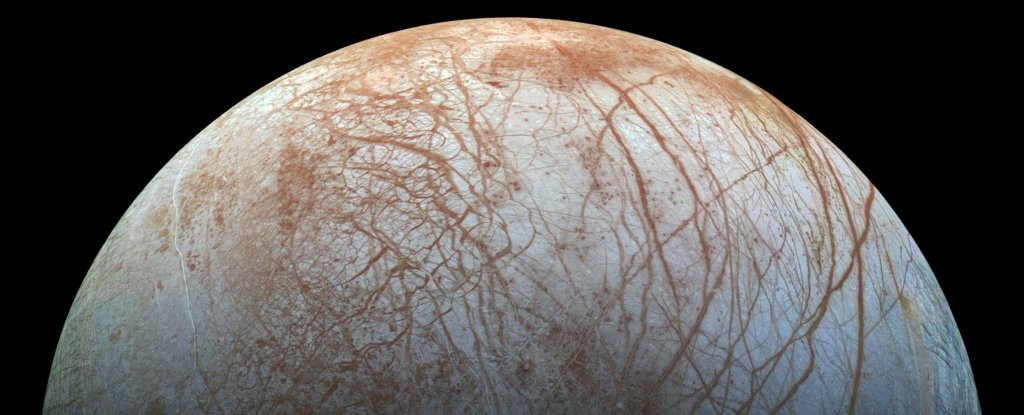Products You May Like
The search for extraterrestrial life is increasingly homing in on the Solar System’s ocean worlds, and there’s new evidence that Jupiter’s moon Europa should be the first port of call. According to new modelling, Europa’s subsurface oceans should be able to support life.
The NASA team behind this research has also calculated that processes such as radioactive decay or tidal forces could have generated sufficient heat to allow for such liquid water on the icy moon, where surface temperatures never exceed about -140 degrees Celsius (-225 degrees Fahrenheit).
The findings have been presented at the 2020 Goldschmidt Conference, and are yet to be peer-reviewed, but they’re just the latest in a long line of clues that implicate Europa as a possible life-bearing world.
We’re not quite sure what form extraterrestrial life might take if we can find it, but ocean worlds such as Europa and Saturn’s moons Enceladus are of great interest. Beneath thick shells of ice, they’re expected to have liquid oceans – plumes of water vapour have been detected spurting out of both.
It’s led to hopes that the moons might harbour life akin to the teeming ecosystems around hydrothermal vents here on Earth. In the cold, dark depths of the ocean, volcanic vents seep heat into the waters around them; there, life is built on chemosynthesis, harnessing chemical energy rather than solar energy to produce food.
Since NASA will be launching a mission to Europa in 2024, scientists have been working to figure out how this mission can search for life signs – and how likely it is to find them. Part of this is working out the likelihood of some of the conditions, and this is what NASA planetary scientists Mohit Melwani Daswani and Steven Vance have been studying.
The main thrust of their research was focused on finding where the water could have come from in the first place. The research suggests it was bound up in water-bearing minerals that were broken down by the heat of radioactive decay, tidal interactions with Jupiter, or a combination of both.
“We were able to model the composition and physical properties of the core, silicate layer, and ocean,” Melwani Daswani explained.
“We find that different minerals lose water and volatiles at different depths and temperatures. We added up these volatiles that are estimated to have been lost from the interior, and found that they are consistent with the current ocean’s predicted mass, meaning that they are probably present in the ocean.”
We know, based on earlier research, that Europa is pretty salty, leading to hopes that its oceans are fairly similar to Earth’s. The researchers’ simulation also modelled the composition of the Europan ocean over time, and found that it probably started out mildly acidic, as Earth’s may have, with high concentrations of carbon dioxide, sulfate, and calcium.
“Indeed it was thought that this ocean could still be rather sulphuric, but our simulations, coupled with data from the Hubble Space Telescope, showing chloride on Europa’s surface, suggest that the water most likely became chloride rich,” Melwani Daswani said.
“In other words, its composition became more like oceans on Earth. We believe that this ocean could be quite habitable for life.”
The next step will be investigating if some of the other conditions for life are likely. The venting of plumes from Europa’s surface indicates that the moon is geologically active, its dance with Jupiter and moons Io and Ganymede causing interior stresses that could be keeping the ocean liquid.
We still don’t know if Europa is volcanically active, capable of producing the hydrothermal vents around which deep-sea life clusters here on Earth. If it is, that activity could have contributed to the chemical evolution of Europa’s ocean – Melwani Daswani and Vance have teamed up with groups in Nantes and Prague to find out if that is the case.
“Europa is one of our best chances of finding life in our Solar System. NASA’s Europa Clipper mission will launch in the next few years, and so our work aims to prepare for the mission, which will investigate Europa’s habitability,” Melwani Daswani said.
“Our models lead us to think that the oceans in other moons, such as Europa’s neighbour Ganymede, and Saturn’s moon Titan, may also have formed by similar processes. We still need to understand several points though, such as how fluids migrate through Europa’s rocky interior.”
The findings have been presented at the Goldschmidt Conference.
